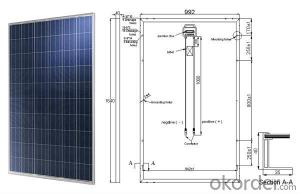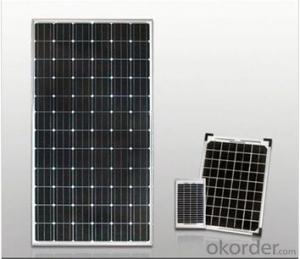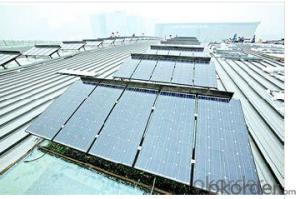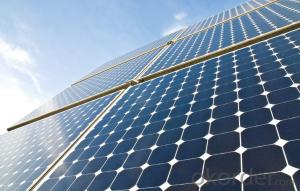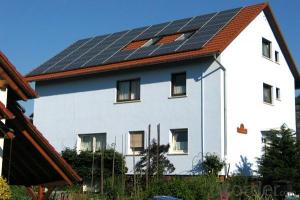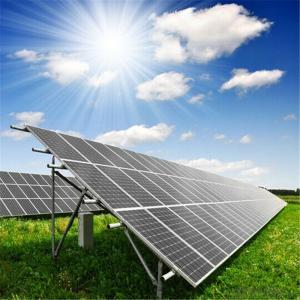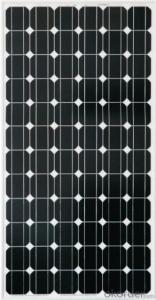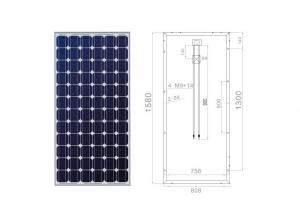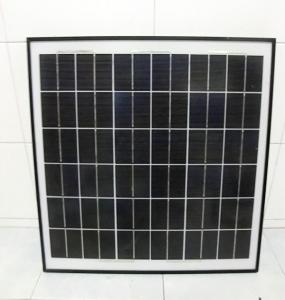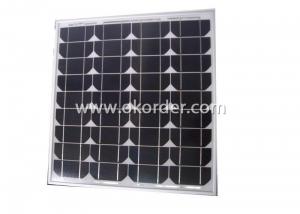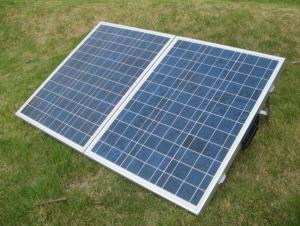Monocrystalline Solar Module 255W for 1500 Sq Ft Home Cost
- Loading Port:
- China Main Port
- Payment Terms:
- TT OR LC
- Min Order Qty:
- -
- Supply Capability:
- -
OKorder Service Pledge
OKorder Financial Service
You Might Also Like
Solar Monocrystalline (210W-225W)
Introduction of Solar Monocrystalline (210W-225W)
Solar modules use light energy (photons) from the sun to generate electricity through the photovoltaic effect. The majority of modules use wafer-based crystalline silicon cells or thin-film cells based on cadmium telluride or silicon. The structural (load carrying) member of a module can either be the top layer or the back layer. Cells must also be protected from mechanical damage and moisture. Most solar modules are rigid, but semi-flexible ones are available, based on thin-film cells. These early solar modules were first used in space in 1958.
CNBM Solar photovoltaic (PV) Panel is designed for large electrical power requirements. It is the optimal choice for both on-grid and off-grid power systems. CNBM Solar panel offers high performance of power per square foot of solar array. Monocrystalline silicon(c-Si): often made using the Czochralski process. Single-crystal wafer cells tend to be expensive, and because they are cut from cylindrical ingots, do not completely cover a square solar cell module without a substantial waste of refined silicon. Hence most c-Si panels have uncovered gaps at the four corners of the cells.
Characteristics of Solar Monocrystalline (210W-225W)
I. Solar Cell : High efficiency crystalline solar cell. Even if under the weak light, the solar module can produce maximum power output.
II. Tempered glass (toughened glass): Anti-reflecting coating and high transmission rate glass increase the power output and mechanical strength of solar module.
III. EVA and TPT: Using high quality EVA and TPT to prevent destroying and water.
IV. AI frame: Without screw, corner connection. 6 holes on the frame can be installed easily.
V. Junction box: Multi function junction box with water proof.
VI. Long lifetime: ≥25 years; Less power decrease.
VII. Good performance of preventing from atrocious weather such as wind and hails.
VIII. Resisting moisture and etching effectively, not effected by geology.
IX. The certificate issued by international authority: UL, TUV, IEC, VDE, CE.
Standard Test Conditions of Solar Monocrystalline (210W-225W)
The opto-electrical specifications shown below are stabilized values being measured at Standard Test Conditions, Irradiance: 1000W/m2, Spectrum: AM1.5 at 25°C, The info below is subject to manufacturing tolerances. Where appropriate minutes of measurement are available and are used for the dimensioning of the installation.
Advantages of Solar Monocrystalline (210W-225W)
• CNBM Solar performance guarantees for 25 years
• 10 years guarantee for workmanship
• Timeliness of delivery
• Quality Products certified (TÜV, UL, CE, VDE, ISO)
CNBM International Corporation's products including Monocrystalline Solar Panel, Polycrystalline Solar Panel have received and enjoyed famous reputation in many countries and regions in the world .As a solar panel manufacturer in China, we strive to provide our customers with excellent service, superior products and unmatched value.
- Q: Hello, I have been trying to go green, I Have purchase somesolar panel they are about 45watts I been putting it against my window and getting ok power out of it enough for my lights and a couple of low watts gadget (cellphone, 2v light, portable dvd) for couple of hours.But its seem to drain the 2v faster then I can charge Am I getting the most power out of my panel?Or should I place it on the roof? I'm in Texas and it gets hot and sunny the sun beam my room windows pretty good during 4pm-6pm.
- Solar panel generates fairly low, unreliable source of energy. They are most likely very expensive. Despite all of that, your window may act as a beam filter by refracting the beam or reflects them off trough total internal reflection causing a low yield of sunlight harvest. Sunlight is also necessary to hit the panel 90 degrees to harvest maximum output.
- Q: Hi, I have in my sailboat 2 2 V batteries. I would like to buy solar panel(s) in order to recharge them. As i am in mexico and there is always high sun . i think it is a good idea.Usage of the batteries is very light . I have found 5-2V pannels with 80mA that fit in the sailboat. I want to know if and how i can have like 5 to 0 of them set together to charge the batteries and what other material would i need.also, i would like to know what happend if the pannels only send on 5V in a 2 V battery? Is it still charging but on 40 % of the capacity a 2 v pannel would charge or its just not doing nothing ?
- 0 of the panels wired in parrell will give you enough power to trickle charge the batteries. You will need a charge controller to prevent a overcharge from damaging your batteries. A panel array that is rated at 2 volts actually puts out a unregulated voltage up to 2 volts. I have bought some charger controllers from OKorder at good prices. They will also prevent the discharge of your batteries at night or when the panels are in the shade. If the panels only put out 5 volts they will not charge the batteries. Check each panel outside in the sun with a DC volt meter for proper operation before connecting them.
- Q: Mono-crystalline or poly-crystalline solar panel?
- All solar photovoltaics drop in efficiencies with higher temperatures but it isn't the 45+ C you have to worry about but rather the heat from the sunlight striking the panels. There are hybrid systems which passes water in pipes attached to the back of the solar panels to cool the panels and preheat the water for solar thermal collectors. The difference between mono-crystalline and poly-crystalline are that mono-crystalline are more efficient and more costly to make.
- Q: Can solar panels be installed on churches or religious institutions?
- Yes, solar panels can definitely be installed on churches or religious institutions. In fact, many religious organizations have embraced solar energy as a way to reduce their carbon footprint and promote sustainable practices. Installing solar panels on churches not only helps them save on electricity costs but also serves as a visible commitment to environmental stewardship and can inspire the community to adopt clean energy solutions.
- Q: Someone Said It costed them 50,000 To Install Solar Panel In their House and 35,000 For Installation. Is that true?
- Are they saying that the panels cost $5k and the installation cost $35k? Or are they saying the panels were $50k, plus another $35k for installation, making the total $85k? Possibly the data was from several years ago. $5k buys 6 kW of panels today, larger than goes on most houses. Installation depends on local labor costs, but should not be more than about $5k in the US, unless the system is huge, or unusual, such as a standalone system on a concrete pad, instead of just on the roof. The system on our roof is roughly 3 kilowatts. If installed today, the parts would cost about $9k. After federal tax credit, $7k. Labor depends on the local situation. We installed our own, so didn't pay any labor cost.
- Q: What is the impact of tree shading on solar panels' efficiency?
- The impact of tree shading on solar panels' efficiency is negative as it reduces the amount of sunlight reaching the panels and therefore decreases their energy production.
- Q: Can solar panels be used in areas with high levels of drought?
- Yes, solar panels can be used in areas with high levels of drought. Solar panels do not require water to generate electricity, as they rely on sunlight to produce energy. Therefore, they can be effectively utilized in regions experiencing drought conditions without any significant impact on their performance or efficiency.
- Q: How much is the cost of solar panels including installation for my home so that I can have low monthly power bills.
- You can start as small as 7,500. It all according to how much you want to run off solar and your Environment. You can move into Solar slowly as the technology Improves every six months or so.
- Q: What is the typical warranty period for solar panels?
- The typical warranty period for solar panels is around 25 to 30 years.
- Q: Can solar panels be installed on a theme park or tourist attraction?
- Yes, solar panels can be installed on a theme park or tourist attraction. Solar panels are a versatile and sustainable energy solution that can be implemented in various settings, including theme parks and tourist attractions. By harnessing solar energy, these establishments can reduce their carbon footprint, lower energy costs, and promote environmental stewardship. Additionally, solar panels can be integrated into the design of these attractions, enhancing their aesthetics and providing an educational opportunity for visitors to learn about renewable energy.
Send your message to us
Monocrystalline Solar Module 255W for 1500 Sq Ft Home Cost
- Loading Port:
- China Main Port
- Payment Terms:
- TT OR LC
- Min Order Qty:
- -
- Supply Capability:
- -
OKorder Service Pledge
OKorder Financial Service
Similar products
Hot products
Hot Searches
Related keywords







